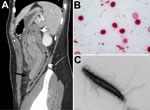Volume 22, Number 2—February 2016
Letter
Acute Colitis Caused by Helicobacter trogontum in Immunocompetent Patient
To the Editor: In industrialized countries, diarrhea and vomiting associated with acute gastrointestinal illness is estimated to occur at a rate of ≈1 episode per person per year; ≈0.3% of patients are hospitalized because of severe symptoms associated with colitis or fever. The most commonly identified infectious agents of non-nosocomial diarrhea are calicivirus and Salmonella, Campylobacter, Giardia, and Cryptosporidium spp. However, for numerous cases, the causative agent is not identified. Helicobacter species other than H. pylori, but not H. trogontum, have emerged as causes of gastrointestinal and systemic disease, mainly in immunocompromised patients (1). We report a case of community-acquired colitis with bacteremia caused by H. trogontum in an immunocompetent patient and emphasize the diagnostic difficulties.
The patient was a 31-year-old woman with a history of recurrent epigastralgia, vomiting, diarrhea, and weight loss of 10 kg over an 8-year period. In April 2014, she was admitted to the Hôpital Européen Georges Pompidou emergency ward (Paris, France) because of abdominal pain, nonbloody diarrhea, fever, and chills, which had persisted for 3 days. Examination revealed a mildly tender abdomen without hepatosplenomegaly, signs of slight dehydration, and tachycardia. Leukocyte count was 13.2 × 109 cells/L (neutrophils, 11.4× 109), and C-reactive protein level was 191 mg/L. Abdominal computed tomography images showed nonspecific right and transverse colitis (Figure, panel A).
One day after admission, the patient was discharged with empirically prescribed ciprofloxacin and metronidazole for 7 days. After 4 days, aerobic blood culture was positive for motile, fusiform, gram-negative bacilli, suggestive of strictly aerobic bacteria that could not be identified directly (Figure, panels B, C). After 7 days of incubation under a microaerophilic atmosphere only, a blood subculture isolate was obtained; 23S and 16S rDNA sequencing (Technical Appendix) identified this isolate as H. trogontum. Of note, use of matrix-assisted laser desorption/ionization time-of-flight mass spectrometry (Bruker Daltonik GmbH, Bremen, Germany) did not enable identification of the bacterium.
No common pathogens were detected in fecal samples. Upper and lower gastrointestinal endoscopic examinations conducted 1 month after discharge revealed no notable abnormalities. No immunocompromised condition was found. At most recent follow-up examination, the patient was free of symptoms.
The genus Helicobacter currently comprises 48 formally named species belonging to the gastric or enterohepatic group according to their ecologic niche. H. trogontum (enterohepatic group) has been isolated from apparently health animals (rat and piglet intestinal mucosa and swine feces), but its characteristics are typical of pathogenic bacteria ([2,3], Technical Appendix). The apparent in vitro susceptibility of the isolate to metronidazole and the favorable patient outcome reported here are in agreement with the finding that metronidazole is an effective treatment for H. trogontum infection in rats ([4]; Technical Appendix), but there are no antimicrobial drug susceptibility data for H. trogontum isolated from animals. We assume that the immunocompetent patient reported here had chronic colitis caused by H. trogontum, followed by an episode of acute colitis with bacteremia after several years of intermittent symptoms.
The rarity of reported H. trogontum infections might be linked to the difficulty associated with culturing and identifying the bacterium or to a low level of exposure to this pathogen. The mode of transmission, probably from animals to humans, remains unclear. Methods for isolation and rapid identification of H. trogontum, including the updating of matrix-assisted laser desorption/ionization time-of-flight mass spectrometry databases, are needed for further elucidation of its pathogenic properties and the mode of contamination.
References
- Fox JG. The non-H pylori helicobacters: their expanding role in gastrointestinal and systemic diseases. Gut. 2002;50:273–83. DOIPubMedGoogle Scholar
- Mendes EN, Queiroz DM, Dewhirst FE, Paster BJ, Moura SB, Fox JG. Helicobacter trogontum sp. nov., isolated from the rat intestine. Int J Syst Bacteriol. 1996;46:916–21. DOIPubMedGoogle Scholar
- Kaakoush NO, Sirianni A, Raftery MJ, Mitchell HM. The secretome of Helicobacter trogontum. Helicobacter. 2013;18:316–20. DOIPubMedGoogle Scholar
- Nahidi L, Leach ST, Mitchell HM, Kaakoush NO, Lemberg DA, Munday JS Inflammatory bowel disease therapies and gut function in a colitis mouse model. Biomed Res Int. 2013;2013:909613. DOIPubMedGoogle Scholar
Figure
Cite This Article1These authors contributed equally to this article.
Related Links
Table of Contents – Volume 22, Number 2—February 2016
| EID Search Options |
|---|
|
|
|
|
|
|

Please use the form below to submit correspondence to the authors or contact them at the following address:
Isabelle Podglajen, Service de Microbiologie, Assistance Publique-Hôpitaux de Paris, Hôpital Européen Georges Pompidou, 20 Rue Leblanc, 75015 Paris, France
Top